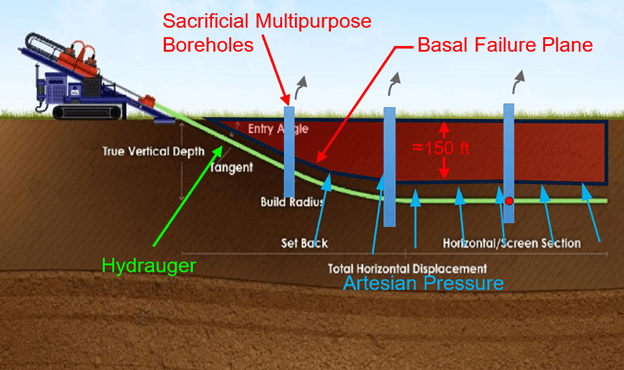Truth matters. Community matters. Your support makes both possible. LAist is one of the few places where news remains independent and free from political and corporate influence. Stand up for truth and for LAist. Make your year-end tax-deductible gift now.
Palos Verdes landslide drilling operation could hit a geyser of water next week

It's been nearly a month since the city of Rancho Palos Verdes started drilling bore holes as part of a long-term effort to slow the Portuguese Bend landslide, which has accelerated in recent years and is threatening a number of neighborhoods in the area.
So far, four out of the 20 exploratory boreholes have been completed at both the top of the slide and along Palos Verdes Drive South, offering insight into what's going on beneath the surface. Experts are analyzing soil conditions and trying to locate the pockets of water they believe are making the slide worse.
The idea is that water's been getting trapped by layers of thick and sticky clay, adding weight to the hillsides. Once they locate the water, they'll start to pump it out with hydraugers — the hope being that as the weight is relieved, the slide will slow.

The groundwater level is a bit shallower than anticipated, and the slide zones are a bit deeper, according to David Copp, deputy director of public works for the city.
"It speaks to the need to drill these vertical boreholes to validate our models," he said.
Drilling's has been slower than projected, as crews hit hard to penetrate material and had to accommodate extensive data gathering. As such, the timeline for information from their third and fourth boreholes will take two weeks longer to finish analyzing.
They're hoping to complete the 20 boreholes by early September, and may bring in an additional drilling rig to speed up the process.
A big week ahead
Next week, drilling is likely to start on the fifth well at the bottom of the slide in an effort to find what they believe is an artesian well — or water under pressure — pushing up on the land and exacerbating movement.
If they do hit an artesian well, there's a chance that water will burst out and start draining.
"Seeing a geyser rush out on the first borehole that we drill at the beach club means that we're headed in the right direction," said Copp.
If the draining is effective, it could take anywhere from two to six months to potentially see land movement slow down.
As of now, the land is still moving as much as one foot per week in some locations. Meanwhile, many residents could lose their homes at any time.








